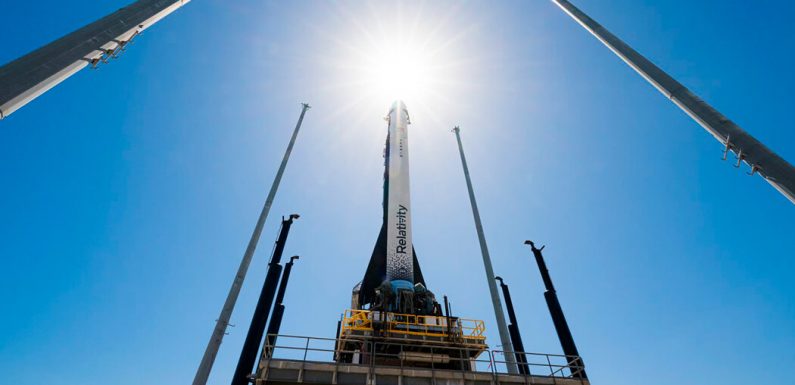
Terran 1, a rocket designed and built by the company Relativity Space, suffered a failure shortly after lifting off from a launchpad in Cape Canaveral, Fla., late on Wednesday night. A demonstration mission, the rocket was not carrying people or a customer payload, and no one was hurt.
The vehicle was powered by nine 3-D printed engines, and would have been the first rocket launched into orbit using liquid methane as its fuel. During a webcast of Wednesday’s flight, the rocket rose on a column of white flame that flared blue as it shot into space.
But about four minutes into the flight, shortly after the rocket’s first stage had dropped away, Clay Walker, the launch director for Relativity Space, said on the company’s webcast that a “T-plus anomaly with stage two” had occurred, meaning there was a problem with the second stage of the rocket, which was to carry its payload to orbit.
The hosts of the company’s webcast said additional details about the problem would be announced at a later time.
Following the success of Elon Musk’s SpaceX, investors have poured money into new spaceflight companies. A number of these businesses have interplanetary ambitions, including Relativity Space, which announced last year that it would team up with another company called Impulse Space to send a private space mission to Mars, aiming to beat Mr. Musk’s company to the red planet.
But many nascent spaceflight companies experience difficulties in their early attempts to get to orbit. In January, a Virgin Orbit spacecraft failed an hour into its flight; the company since has furloughed employees. Another company, ABL Space Systems, lost its first rocket just after liftoff from a base in Alaska. And even established rocket builders lose new rockets on their first flight. Earlier this month, a new rocket built for Japan’s space agency by Mitsubishi Heavy Industries, which has produced rockets for decades, failed minutes into its first flight and lost the satellite it was to deploy.
Wednesday’s Relativity flight did not lose a customer’s satellite. Its only cargo was a wheel-shaped object, the first thing ever made by Relativity’s 3-D printers, which was to demonstrate the rocket’s ability to carry a payload to orbit.
The flight, which the company nicknamed “Good Luck, Have Fun” or G.L.H.F., was the company’s third launch attempt in the past two weeks. The previous two were canceled for a range of technical issues shortly before liftoff.
During Wednesday’s launch, the company noted some of the milestones achieved by the rocket. It was the first time a 3-D printed rocket had reached “max-q,” the point when the vehicle experiences the strongest stresses, and also stage separation, when the booster used for liftoff drops from the vehicle’s second stage.
Relativity Space is among a number of new companies manufacturing and testing small-lift launch vehicles: rockets that can carry smaller payloads of around two tons or less, typically with a destination of low-Earth orbit.
At 110 feet tall, Terran 1 fell into this “small launch” category, and is planned as a precursor for a much larger, reusable launcher, Terran R, which the company hopes to begin testing soon.
To make these rockets, Relativity Space has developed massive 3-D printers in Long Beach, Calif., that use robotic arms to craft engines and other parts out of metal alloys that can withstand the heat and pressure of ignited rocket fuel.
Traditional manufacturing processes often slow rocket building. But 3-D printers, which turn code into physical objects, allow engineers to move more quickly from design to testing. Instead of having to create a totally new part, engineers can just instruct the printers to increase the size of existing parts, or modify them in other ways.
Because of this, there are many 3-D printed parts in modern rockets. But Relativity Space is treating 3-D printers as a one-stop shop for nearly all of its rockets. Some 85 percent of the mass of Terran 1 was made using 3-D printers, and each rocket can be crafted from nothing in 60 days.
Relativity is among several companies building rockets to launch into orbit using liquid oxygen and liquid methane as propellants. In the past, most rockets have relied on hydrogen or kerosene for fuel. Methane — the primary component of liquid gas — is easier to store than hydrogen and offers better performance than kerosene. Starship, the next-generation rocket being built by SpaceX for missions to the moon and Mars, will use similar propellants.
Carissa Christensen, the founder and chief executive of the space analytics firm BryceTech, noted that, of the hundreds of space start-ups created in recent years, only a handful have reached the launchpad. This alone sets Relativity Space apart from many other private companies racing to launch rockets. It shows “something of a proof point of the investment thesis,” Ms. Christensen said in an interview earlier this month.
A launch attempt, whether it is successful or not, is something Ms. Christensen celebrates.
“It’s a step in a path of a complex engineered system,” she said of the Terran 1 flight. “Succeed or fail, they’ll learn something from it.”
Source: Read Full Article